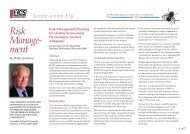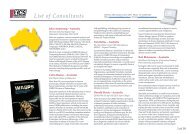Manual for Diagnosis of Screw-worm Fly - xcs consulting
Manual for Diagnosis of Screw-worm Fly - xcs consulting
Manual for Diagnosis of Screw-worm Fly - xcs consulting
Create successful ePaper yourself
Turn your PDF publications into a flip-book with our unique Google optimized e-Paper software.
A <strong>Manual</strong> <strong>for</strong> the <strong>Diagnosis</strong> <strong>of</strong> <strong>Screw</strong>-Worm <strong>Fly</strong><br />
Preface<br />
This manual was commissioned and funded by Agriculture, Fisheries and Forestry - Australia<br />
as part <strong>of</strong> its Exotic Disease Preparedness Program. Its purpose is to make readily available<br />
a means <strong>of</strong> recognising and identifying screw-<strong>worm</strong> fly.<br />
Inquiries relating to this <strong>Manual</strong> should be directed to:<br />
Office <strong>of</strong> the Chief Veterinary Officer<br />
Agriculture, Fisheries and Forestry - Australia<br />
GPO Box 858<br />
Canberra, ACT 2601<br />
Foreword to the Reprint<br />
Since the <strong>Manual</strong> <strong>for</strong> <strong>Diagnosis</strong> <strong>of</strong> <strong>Screw</strong>-<strong>worm</strong> <strong>Fly</strong> was published ten years ago, it has been<br />
an invaluable aid in the identification <strong>of</strong> insects or larvae affecting animals, and on occasions<br />
humans.<br />
In 1992, the manual established its credibility when larvae from a lesion on the neck <strong>of</strong> a<br />
tourist returning to Australia from South America were positively identified as Cochliomyia<br />
hominivorax, or the New World <strong>Screw</strong>-<strong>worm</strong> fly. The availability <strong>of</strong> the manual enabled a<br />
rapid diagnosis, and the incident was promptly resolved. Many other suspect flies collected<br />
by surveillance programs and disease investigations have been quickly identified using the<br />
manual. Fortunately no further screw-<strong>worm</strong> flies or larvae have since been detected in<br />
Australia. However, in October 2001, flies from surveillance traps on the island <strong>of</strong> Boigu, far<br />
north Torres Strait, were suspected to be the first case <strong>of</strong> Chrysomya bezziana in Australian<br />
territory. Fortunately, the specimens were shown to be Chrysomya megacephala, a species<br />
already within Australia. Again, the manual provided the necessary in<strong>for</strong>mation to distinguish<br />
the Old World <strong>Screw</strong>-<strong>worm</strong> fly from this similar species.<br />
Copies <strong>of</strong> the manual have been distributed throughout Australia and around the world. The<br />
continuing high demand <strong>for</strong> the manual led us to republish with minor amendments, to ensure<br />
Australia’s screw-<strong>worm</strong> fly diagnostic capabilities remain at the highest standard.<br />
Dr Philip Spradbery, now a private consultant in Canberra, has again prepared the amended<br />
text. We thank him <strong>for</strong> contributing the revisions he has personally accumulated throughout<br />
the years.<br />
Now in it’s second decade <strong>of</strong> circulation, I trust that this revised <strong>Manual</strong> <strong>for</strong> the <strong>Diagnosis</strong> <strong>of</strong><br />
<strong>Screw</strong>-<strong>worm</strong> <strong>Fly</strong> will continue to serve your needs in the differentiation <strong>of</strong> screw-<strong>worm</strong> flies<br />
and similar insects.<br />
Gardner Murray<br />
Australian Chief Veterinary Officer and<br />
Executive Manager,<br />
Product Integrity Animal & Plant Health<br />
Agriculture, Fisheries and Forestry - Australia<br />
March 2002<br />
ii




